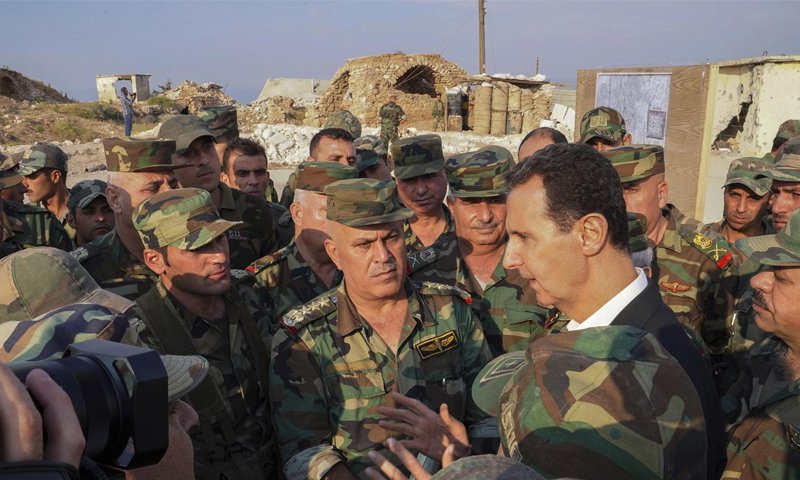The circular by which Bashar al-Assad, head of the Syrian regime and commander-in-chief of the Syrian Armed Forces, has ordered rolling back army readiness to pre-2012 levels, poses several questions regarding the decision’s timing and the political and economic factors that urged it?
Under the circular, dispatched to relevant army entities on 10 January, combat readiness was scaled down in all departments of the Syrian military; reduced from 66 to 33 percent in administrative departments, and from 80 to 50 percent in their affiliated military units.
Readiness within the Ground Forces and the Navy was reduced from 100 to 80 percent. In military hospitals, however, readiness continues unchanged, maintained at 80 percent.
An informed source, a non-commissioned officer at one of the army’s operation rooms, told Enab Baladi that the room received a fax letter with the above orders on 10 January. The next day, a copy of the circular arrived in, signed by the general commander.
The detachment was fast to reassemble forces according to the rates in the circular, the source added.
The essential part of the circular, the source added, was an article that provided for reducing food shares allocated to barracks because recruits will be permitted more leaves under the new orders.
Military Hoax?
This could not be a military trick, military analyst colonel Ziad Haj Obeid told Enab Baladi. “The Syrian regime’s cards are all on the table. The regime is having a difficult time, particularly in relation to economy.”
“There is also the international actors, which would not allow for any other military offensives or new battles without an agreement with Russia first, and Hezbollah second,” he added.
On timing, as to whether the regime has synced lowering military readiness to attacks by the Islamic State (IS) on its forces in the desert areas, Obeid said, “military action against IS is guided by Iran, with international blessings. The regime is unable to control the situation in the Syrian desert.”
“The regime has discharged five percent of its reserve and national defense forces. These refused to fight in the desert. Discharges were carried out in Deir ez-Zor, Raqqa and Aleppo only,” Obeid added.
Such losses of human resources would not affect the regime’s military strategy, as it compensates for the released troops with the recruitment drives it launches every six months.
Political and economic motives
The decision to lower military readiness has several aims, Director of Jusoor for Studies, Muhammad Sarmini, told Enab Baladi. Most importantly, these curtails seek to mitigate resentment building up within the ranks of the regime’s popular incubator, which has been protesting long enlistment time for both reserve and mandatory service recruits.
With these changes the Syrian regime also aims to convey a message to Syrians and to the world before the elections that the regime is in control of the country, the opposition failed to shake its powers, and the war is soon to end.
In relation to finance, the regime is attempting to address the monetary burdens hampering the military institution’s activities by reducing the number of conscripts and officers that are on duty and cutting the costs of food and transportation army departments pay them.
Pro-opposition journalist Ayman Abdel Nour shares Sarmini’s opinion on this matter.
In a Message to Syrians broadcast, Abdel Nour said that Bashar al-Assad has opted for lowering military readiness due to tightening finances. By reducing the number of active recruits and army staffers, the regime seeks to rein in the money it is investing in the army, such as salaries, food allocations, and costs of munition that is used in training.
The regime is paying an estimated 40 to 45 million dollars per month in salaries to active and retired military staffers, which is an amount that the regime no longer has, he added.
Before 2011, the total number of the Syrian Army was estimated at about 325,000 men, of which 220,000 were ground forces. The army consists of three main forces: Ground Forces, Air Forces (100,000 men including 40,000 in air forces and 60,000 in air-defense), and Navy (4,000 men), according to a report issued by the Russian International Affairs Council (RIFC).
Prior to the revolution, the army predominantly consisted of conscripts who served 2.5 years. During peacetime, up to 125,000 men were conscripted into the army annually. It also had 354,000 reservists, reported the RIFC.
After 2011, the army’s military strength went down by an estimated two-thirds. In 2012, the Russian and Iranian military assistance has staved off the collapse of the regime and its forces, according to Syria Profile by Tawazun—Index of Arab Civil-Military Relations.
In 2020, the number of the Syrian Army combatants is an estimated 169,000, Tawazun reported, concluding that the Syrian regime’s army has “low efficiency” in the areas of governance, military professionalism, social and cultural perception, defense finance and economics, and civilian competence.

